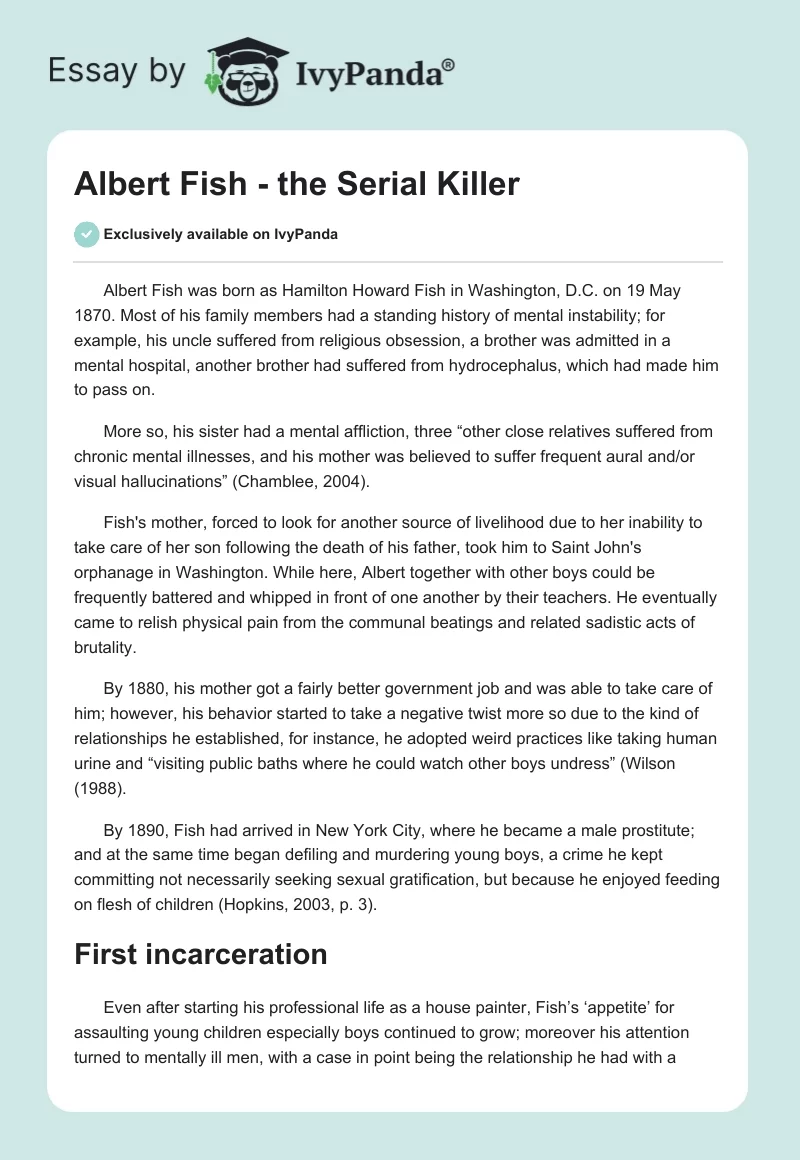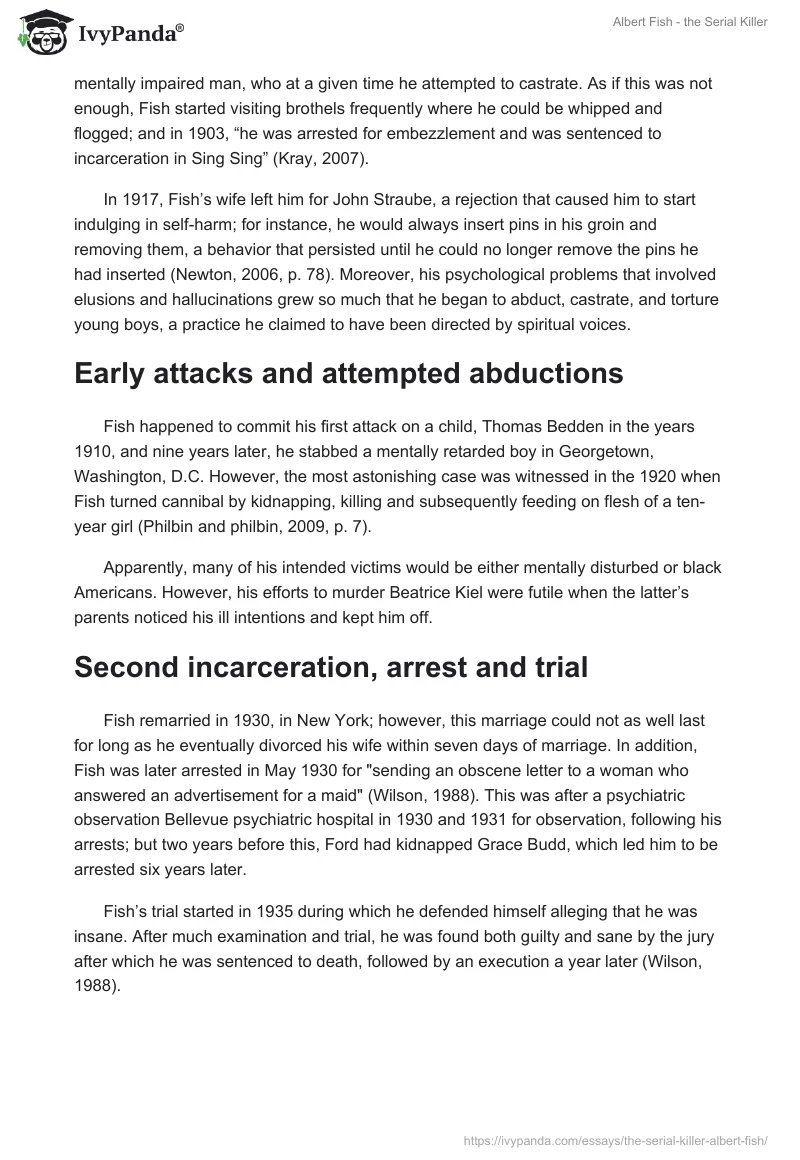Albert Fish was born as Hamilton Howard Fish in Washington, D.C. on 19 May 1870. Most of his family members had a standing history of mental instability; for example, his uncle suffered from religious obsession, a brother was admitted in a mental hospital, another brother had suffered from hydrocephalus, which had made him to pass on.
More so, his sister had a mental affliction, three “other close relatives suffered from chronic mental illnesses, and his mother was believed to suffer frequent aural and/or visual hallucinations” (Chamblee, 2004).
Fish’s mother, forced to look for another source of livelihood due to her inability to take care of her son following the death of his father, took him to Saint John’s orphanage in Washington. While here, Albert together with other boys could be frequently battered and whipped in front of one another by their teachers. He eventually came to relish physical pain from the communal beatings and related sadistic acts of brutality.
By 1880, his mother got a fairly better government job and was able to take care of him; however, his behavior started to take a negative twist more so due to the kind of relationships he established, for instance, he adopted weird practices like taking human urine and “visiting public baths where he could watch other boys undress” (Wilson (1988).
By 1890, Fish had arrived in New York City, where he became a male prostitute; and at the same time began defiling and murdering young boys, a crime he kept committing not necessarily seeking sexual gratification, but because he enjoyed feeding on flesh of children (Hopkins, 2003, p. 3).
First incarceration
Even after starting his professional life as a house painter, Fish’s ‘appetite’ for assaulting young children especially boys continued to grow; moreover his attention turned to mentally ill men, with a case in point being the relationship he had with a mentally impaired man, who at a given time he attempted to castrate. As if this was not enough, Fish started visiting brothels frequently where he could be whipped and flogged; and in 1903, “he was arrested for embezzlement and was sentenced to incarceration in Sing Sing” (Kray, 2007).
In 1917, Fish’s wife left him for John Straube, a rejection that caused him to start indulging in self-harm; for instance, he would always insert pins in his groin and removing them, a behavior that persisted until he could no longer remove the pins he had inserted (Newton, 2006, p. 78). Moreover, his psychological problems that involved elusions and hallucinations grew so much that he began to abduct, castrate, and torture young boys, a practice he claimed to have been directed by spiritual voices.
Early attacks and attempted abductions
Fish happened to commit his first attack on a child, Thomas Bedden in the years 1910, and nine years later, he stabbed a mentally retarded boy in Georgetown, Washington, D.C. However, the most astonishing case was witnessed in the 1920 when Fish turned cannibal by kidnapping, killing and subsequently feeding on flesh of a ten-year girl (Philbin and philbin, 2009, p. 7).
Apparently, many of his intended victims would be either mentally disturbed or black Americans. However, his efforts to murder Beatrice Kiel were futile when the latter’s parents noticed his ill intentions and kept him off.
Second incarceration, arrest and trial
Fish remarried in 1930, in New York; however, this marriage could not as well last for long as he eventually divorced his wife within seven days of marriage. In addition, Fish was later arrested in May 1930 for “sending an obscene letter to a woman who answered an advertisement for a maid” (Wilson, 1988). This was after a psychiatric observation Bellevue psychiatric hospital in 1930 and 1931 for observation, following his arrests; but two years before this, Ford had kidnapped Grace Budd, which led him to be arrested six years later.
Fish’s trial started in 1935 during which he defended himself alleging that he was insane. After much examination and trial, he was found both guilty and sane by the jury after which he was sentenced to death, followed by an execution a year later (Wilson, 1988).
Underlying cause for the evidence for the cause of Albert Fish’s behavior
An analysis of Alvin Ford serial killer’s case is very closely related to that of Albert Fish. In 1986, the “United States Supreme Court used Florida’s procedure for determining mental competency for execution as a test case for banning execution of the mentally ill;” indeed, under Ford v. Wainwright “the eighth amendment prohibits the state from inflicting a penalty of death upon a prisoner who is insane” (Miller, and Radelet, 1993).
Although Florida’s procedure may now be constitutional on its face, in practice, Florida continues to execute the mentally ill. In 1974, Florida charged Alvin Ford with murder, after which he was sentenced to death. At the trial level, Ford raised no competency issues but after imprisonment, he showed symptoms of delusion, confusion, and psychosis.
A fourteen months examination by a defense psychiatrist revealed that Ford was suffering from paranoid Schizophrenia with suicide potential that hindered him the potential to defend his life. Other three governor- appointed psychiatrists examined him for only thirty minutes and discovered that although he exhibited mental disorder, he understood his total situation including his death penalty and the implications thereof (Wilson, 1988).
After the defense psychiatrist examined Ford, he concluded that Ford suffered from paranoid schizophrenia; however, although the examination of other three governor-appointed psychiatrists revealed that Ford suffered from mental disorder, they concluded that he understood his total situation, including his penalty and its implications.
When the case reached the Supreme Court, the Court’s plurality observed that no states allowed the execution of mentally retarded persons. The Justice in concurrence with Ford suggested a procedure used by Florida today that does not require full sanity prior to execution and an individual’s need to assist the counsel in his or her defense.
Even though the court left the standard and procedures open-ended, it clearly indicated that Florida’s procedure totally violated the eighth Amendment in three ways. (1) by denying the prisoner a mechanism to challenge the findings and impeach the findings of the governor appointed psychiatrists, (2) by placing the entire competency determination in the hands of the governor and (3) by preventing the condemned from playing any relevant role in the quest for truth (Chamblee, 2004).
Conclusion
In comparison to Albert Fish’s case, Dempsey termed Fish as ‘a psychological phenomenon’. Psychiatrist Wertham also examined and found Fish to be obsessed with religion, cannibalism, and communion.
Fish himself pleaded insanity; however, although the jury found him sane and guilty, the reports, and examinations from other psychiatrists, rendering him insane should have been put into accurate consideration (Wilson and Seaman, 2004, p. 176). Fish’s activities totally reveal that he was mentally retarded, and if this is true, then the jury totally violated the United States Supreme Court’s eighth amendment.
References
Chamblee, L. E. (2004). Time for a legislative change: Florida’s stagnant standard governing competency for execution. Web.
Hopkins, A. (2003). This Cannibal loved Kids – Literally. Weekly World News, Vol. 24, No. 19. Web.
Kray, K. (2007). The world’s worst crimes of 20 killers and their 1000 victims. Brooklyn, John Blake.
Miller, K. S. and Radelet, M. L. (1993). Executing the mentally ill: Criminal Justice System and the case of Alvin Ford. Michigan, Sage Publications. Web.
Newton, M. (2006). The encyclopedia of serial killers. Edition2. NY, Infobase Publishing. Web.
Philbin, T. and Philbin, M. (2009). The Killer Book of Serial Killers: Incredible Stories, Facts and Trivia from the World of Serial Killers. Texas, Sourcebooks, Inc. Web.
Wilson, C. and Seaman, D. (2004). The Serial Killers. London, Virgin Publishing Ltd.
Wilson, P. (1988). ‘Stranger’ child-murder: Issues relating to causes and controls. Forensic Science International, Volume 36, Issues 3.



